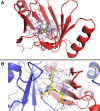ProCogGraph: a graph-based mapping of cognate ligand domain interactions
- PMID: 39544627
- PMCID: PMC11561043
- DOI: 10.1093/bioadv/vbae161
ProCogGraph: a graph-based mapping of cognate ligand domain interactions
Abstract
Motivation: Mappings of domain-cognate ligand interactions can enhance our understanding of the core concepts of evolution and be used to aid docking and protein design. Since the last available cognate-ligand domain database was released, the PDB has grown significantly and new tools are available for measuring similarity and determining contacts.
Results: We present ProCogGraph, a graph database of cognate-ligand domain mappings in PDB structures. Building upon the work of the predecessor database, PROCOGNATE, we use data-driven approaches to develop thresholds and interaction modes. We explore new aspects of domain-cognate ligand interactions, including the chemical similarity of bound cognate ligands and how domain combinations influence cognate ligand binding. Finally, we use the graph to add specificity to partial EC IDs, showing that ProCogGraph can complete partial annotations systematically through assigned cognate ligands.
Availability and implementation: The ProCogGraph pipeline, database and flat files are available at https://github.com/bashton-lab/ProCogGraph and https://doi.org/10.5281/zenodo.13165851.
© The Author(s) 2024. Published by Oxford University Press.
Conflict of interest statement
None declared.
Figures





References
LinkOut - more resources
Full Text Sources
Miscellaneous

